engine HONDA CR-V 2005 RD4-RD7 / 2.G Owner's Guide
[x] Cancel search | Manufacturer: HONDA, Model Year: 2005, Model line: CR-V, Model: HONDA CR-V 2005 RD4-RD7 / 2.GPages: 274, PDF Size: 4.34 MB
Page 168 of 274
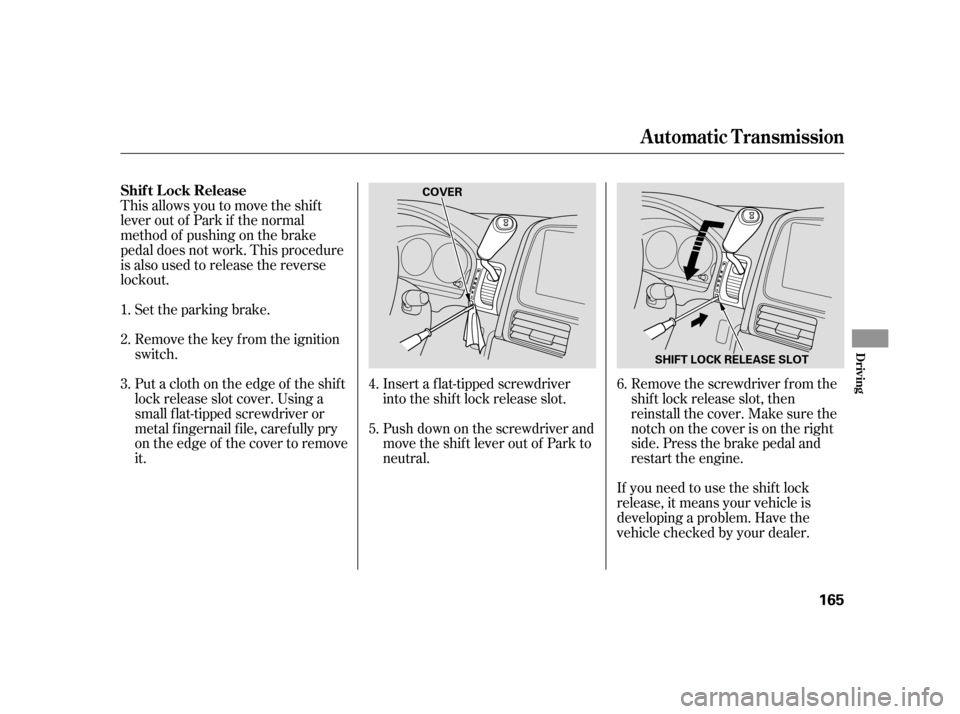
Remove the screwdriver f rom the
shif t lock release slot, then
reinstall the cover. Make sure the
notchonthecoverisontheright
side. Press the brake pedal and
restart the engine.
If you need to use the shif t lock
release, it means your vehicle is
developing a problem. Have the
vehicle checked by your dealer.
Set the parking brake.
Insert a flat-tipped screwdriver
into the shif t lock release slot.
Push down on the screwdriver and
move the shift lever out of Park to
neutral.
This allows you to move the shif t
lever out of Park if the normal
method of pushing on the brake
pedal does not work. This procedure
is also used to release the reverse
lockout.
Remove the key from the ignition
switch.
Put a cloth on the edge of the shif t
lock release slot cover. Using a
small f lat-tipped screwdriver or
metal f ingernail f ile, caref ully pry
on the edge of the cover to remove
it.
6.
1.
2.
3. 4.
5.
Automatic Transmission
Shif t L ock Release
Driving
165
SHIFT LOCK RELEASE SLOT
COVER
Page 170 of 274

Your vehicle is equipped with disc
brakes at all f our wheels. A power
assist helps reduce the ef f ort needed
on the brake pedal. The anti-lock
brake system (ABS) helps you retain
steering control when braking very
hard.
Check your brakes af ter driving
through deep water. Apply the
brakes moderately to see if they f eel
normal. If not, apply them gently and
f requently until they do. Be extra
cautious and alert in your driving.
The hydraulic system that operates
the brakes has two separate circuits.
Each circuit works diagonally across
the vehicle (the lef t-f ront brake is
connected with the right-rear brake,
etc.). If one circuit should develop a
problem, you will still have braking
at two wheels.
The f ront and rear disc brakes on all
models have audible brake wear
indicators.
If the brake pads need replacing, you
will hear a distinctive, metallic
screeching sound when you apply
the brake pedal. If you do not have
the brake pads replaced, they will
screech all the time. It is normal f or
the brakes to occasionally squeal or
squeak when you apply them.
Constant application of the brakes
when going down a long hill builds
up heat and reduces their ef f ective-
ness. Use the engine to assist the
brakes by taking your f oot of f the
accelerator and downshif ting to a
lower gear.
Resting your f oot on the pedal keeps
the brakes applied lightly, builds up
heat, and reduces their ef f ectiveness.
It also keeps your brake lights on all
the time, conf using drivers behind
you.
Braking System
Braking System Design
Brake Pad Wear Indicators
Driving
167
Page 173 of 274

The VSA system cannot enhance the
vehicle’s driving stability in all
situations and does not control your
vehicle’s entire braking system. It is
still your responsibility to drive and
corner at reasonable speeds and to
leave a sufficient margin of safety. The vehicle stability assist (VSA)
system helps to stabilize the vehicle
during cornering if the vehicle turns
more or less than desired. It also
assists you in maintaining traction
while accelerating on loose or
slippery road surf aces. It does this
by regulating the engine’s output and
by selectively applying the brakes.
When VSA activates, you may notice
that the engine does not respond to
the accelerator in the same way it
does at other times. You will also see
the VSA activation indicator blink.When VSA activates, you will see the
VSA activation indicator blink (see
page ).
The VSA system indicator (see page
) comes on and stays on when
there is a problem with the VSA
system. The VSA activation indicator
will also come on.
58
58
Vehicle Stability Assist (VSA) System
VSA A ctivation Indicator
Vehicle Stability A ssist
(VSA ) System Indicator
170
Page 174 of 274
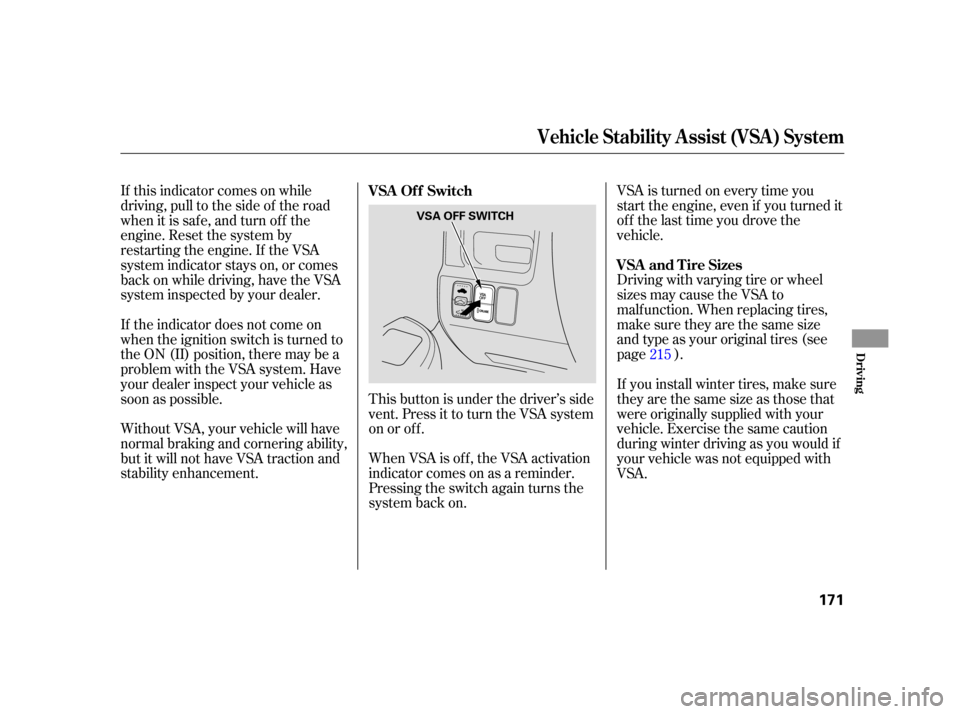
When VSA is off, the VSA activation
indicator comes on as a reminder.
Pressing the switch again turns the
system back on.VSA is turned on every time you
start the engine, even if you turned it
off the last time you drove the
vehicle.
Driving with varying tire or wheel
sizes may cause the VSA to
malf unction. When replacing tires,
make sure they are the same size
and type as your original tires (see
page ).
If this indicator comes on while
driving, pull to the side of the road
when it is saf e, and turn of f the
engine. Reset the system by
restarting the engine. If the VSA
system indicator stays on, or comes
back on while driving, have the VSA
system inspected by your dealer.
If the indicator does not come on
when the ignition switch is turned to
the ON (II) position, there may be a
problem with the VSA system. Have
your dealer inspect your vehicle as
soon as possible.
Without VSA, your vehicle will have
normal braking and cornering ability,
but it will not have VSA traction and
stability enhancement.
This button is under the driver’s side
vent. Press it to turn the VSA system
on or of f .
If you install winter tires, make sure
they are the same size as those that
were originally supplied with your
vehicle. Exercise the same caution
during winter driving as you would if
your vehicle was not equipped with
VSA.215
VSA Of f Switch
VSA and Tire Sizes
Vehicle Stability Assist (VSA) System
Driving
171
VSA OFF SWITCH
Page 175 of 274
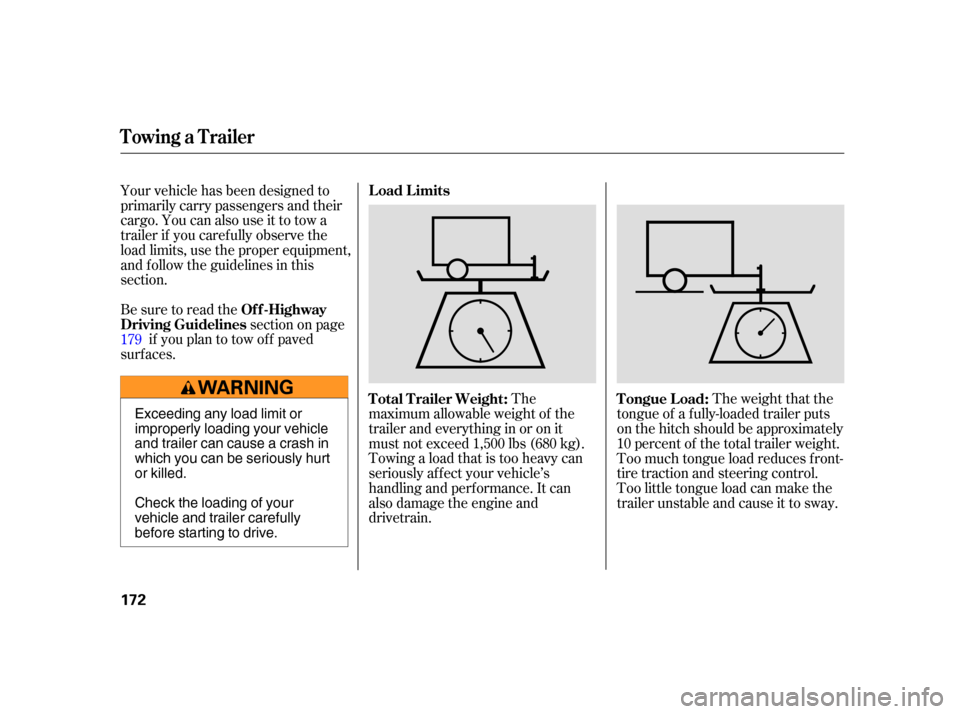
Your vehicle has been designed to
primarily carry passengers and their
cargo. You can also use it to tow a
trailer if you caref ully observe the
load limits, use the proper equipment,
and f ollow the guidelines in this
section.
Be sure to read thesectiononpage
if you plan to tow of f paved
surf aces.
The
maximum allowable weight of the
trailer and everything in or on it
must not exceed 1,500 lbs (680 kg).
Towing a load that is too heavy can
seriously af f ect your vehicle’s
handling and perf ormance. It can
also damage the engine and
drivetrain. Theweightthatthe
tongue of a f ully-loaded trailer puts
on the hitch should be approximately
10 percent of the total trailer weight.
Too much tongue load reduces f ront-
tire traction and steering control.
Too little tongue load can make the
trailer unstable and cause it to sway.
179
Off-Highway
Driving Guidelines Load Limits
T otal T railer Weight:
T ongue L oad:
Towing a Trailer
172
Exceeding any load limit or
improperly loading your vehicle
and trailer can cause a crash in
which you can be seriously hurt
or killed.
Check the loading of your
vehicle and trailer carefully
beforestartingtodrive.
Page 179 of 274

Drive slower than normal in all
driving situations, and obey posted
speed limits f or vehicles with trailers.
If you have an automatic
transmission, use the D position
when towing a trailer on level roads.
D is the proper shif t lever position
to use when towing a trailer in hilly
terrain. (See ‘‘ ’’ in the
f ollowing column f or additional gear
inf ormation.)
Maketurnsmoreslowlyandwider
than normal. The trailer tracks a
smaller arc than your vehicle, and it
canhitorrunoversomethingthe
vehicle misses. Allow more time and
distance f or braking. Do not brake or
turn suddenly as this could cause the
trailer to jackknif e or turn over.
When climbing hills, closely watch
your temperature gauge. If it nears
the red (Hot) mark, turn the air
conditioning of f , reduce speed and, if
necessary, pull to the side of the
road to let the engine cool.
When driving down hills, reduce
your speed and shif t down to 3rd
gear on the manual transmission, or
use the D3 position on the automatic
transmission. Do not ‘‘ride’’ the
brakes, and remember it will take
longer to slow down and stop when
towing a trailer.
If you must stop when f acing uphill,
use the f oot brake or parking brake.
Do not try to hold the vehicle in
placebypressingontheaccelerator,
as this can cause the automatic
transmission to overheat.
Crosswinds and air turbulence
caused by passing trucks can disrupt
your steering and cause the trailer to
sway. When being passed by a large
vehicle, keep a constant speed, and
steer straight ahead. Do not try to
make quick steering or braking
corrections.
Always drive slowly and have
someone guide you when backing up.
Grip the of the steering wheel,
then turn the wheel to the left to get
the trailer to move to the left, and
turn the wheel right to move the
trailer to the right.
Follow all normal precautions when
parking, including f irmly setting the
parking brake and putting the
transmission in Park (automatic) or
in 1st or reverse (manual). Also,
place wheel chocks at each of the
trailer’s tires.
3
bottom
T owing Speeds and Gears
Driving on Hills
Making T urns and Braking
Driving on Hills
Handling Crosswinds and Buf f et ing
Backing Up
Parking
Towing a Trailer
176
Page 180 of 274

Your vehicle can be towed behind a
motorhome at legal highway speeds
up to 65 mph (100 km/h). Do not
exceed 65 mph (100 km/h).
Otherwise, severe transmission
damage will occur. To avoid damage
to the 4WD system, your vehicle
must be towed with all f our wheels
on the ground (f lat towing).
When purchasing a tow bar, make
sure you select a reputable
manuf acturer and installer. Follow
the manufacturer’s attachment
instructions caref ully.Check the transmission f luid level
(see page ).
Release the parking brake.
Leave the ignition switch in the
ACCESSORY (I) position so the
steering wheel does not lock.
Make sure the radio and any items
plugged into the accessory power
sockets are turned of f so you do
not run down the battery.
Perf orm the f ollowing procedure
every day immediately bef ore you
begin towing. Otherwise severe
automatic transmission damage will
occur. Check the transmission f luid level
(see page ).
Start the engine. Press on the brake pedal. Move
the shif t lever through all its
positions.
ShifttoD,thentoN.Letthe
engine run f or 3 minutes, then
turn it off.
Release the parking brake.
Leave the ignition switch in the
ACCESSORY (I) position so the
steering wheel does not lock.
Make sure the radio and any items
plugged into the accessory power
sockets are turned of f so you do
not run down the battery.
When you stop towing your vehicle
and shif t out of the neutral position,
youmaynotbeabletomovethe
shif t lever f rom neutral to reverse or
Park.If thishappens,pressthe
brake pedal and turn the ignition
switch to the ON (II) position, then
shif t out of neutral. Shif t to neutral.
199 200On models with manual transmission
Do not overf ill.
On models with automatic transmission Do not overf ill.
CONT INUED
Towing Your Vehicle Behind a Motorhome
Driving
177
Page 181 of 274
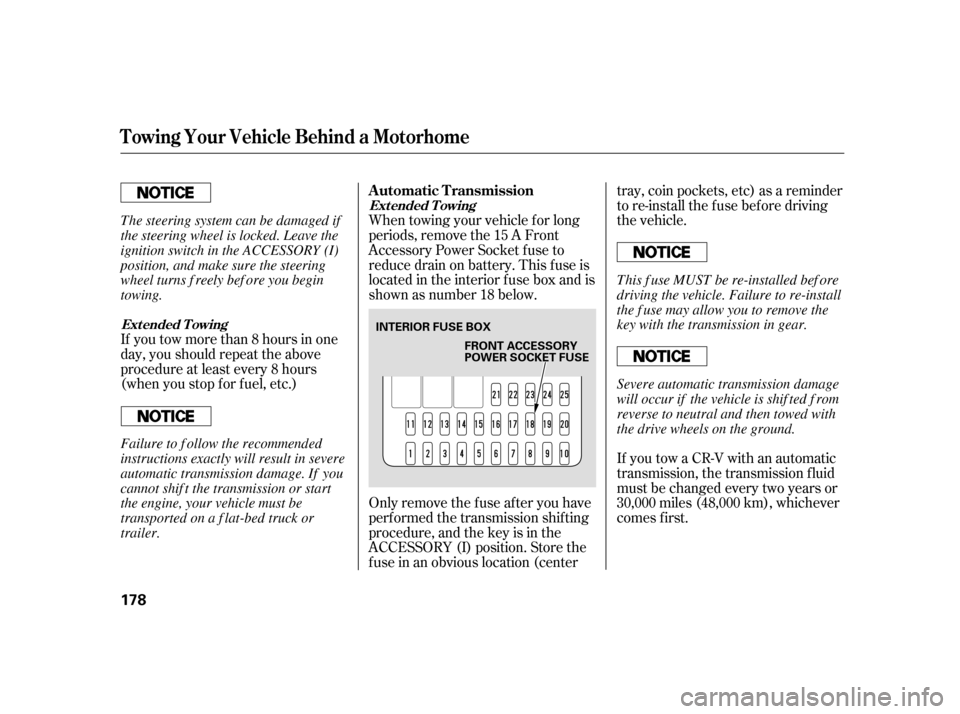
Only remove the fuse after you have
perf ormed the transmission shif ting
procedure, and the key is in the
ACCESSORY (I) position. Store the
f use in an obvious location (center
tray, coin pockets, etc) as a reminder
to re-install the fuse before driving
the vehicle.
If youtowaCR-Vwithanautomatic
transmission, the transmission f luid
must be changed every two years or
30,000 miles (48,000 km), whichever
comes f irst.
When towing your vehicle f or long
periods, remove the 15 A Front
Accessory Power Socket f use to
reduce drain on battery. This f use is
located in the interior f use box and is
shown as number 18 below.
If you tow more than 8 hours in one
day, you should repeat the above
procedure at least every 8 hours
(when you stop f or f uel, etc.)
Towing Your Vehicle Behind a Motorhome
Automatic Transmission
Ext ended T owing
Ext ended T owing
178
INTERIOR FUSE BOX
FRONT ACCESSORY POWER SOCKET FUSE
Severe automatic transmission damage
will occur if the vehicle is shif ted f rom
reverse to neutral and then towed with
the drive wheels on the ground.
This f use MUST be re-installed bef ore
driving the vehicle. Failure to re-install
the f use may allow you to remove the
key with the transmission in gear.
The steering system can be damaged if
the steering wheel is locked. Leave the
ignition switch in the ACCESSORY (I)
position, and make sure the steering
wheel turns f reely bef ore you begin
towing.
Failure to f ollow the recommended
instructions exactly will result in severe
automatic transmission damage. If you
cannot shif t the transmission or start
the engine, your vehicle must be
transported on a f lat-bed truck or
trailer.
Page 186 of 274

This section explains why it is
important to keep your vehicle well
maintained and how to f ollow basic
maintenance saf ety precautions.
If you have the skills and tools to
perf orm more complex maintenance
tasks on your vehicle, you may want
to purchase the service manual. See
page f or inf ormation on how to
obtain a copy, or see your dealer.......................
Maintenance Saf ety .184
.................
Maintenance Schedule . 185
....................
Maintenance Record .189
..............................
Fluid Locations .192
........................
Adding Engine Oil .193
.........
Changing the Oil and Filter . 194
..............................
Engine Coolant .196
....................
Windshield Washers .198
.......................
Transmission Fluid .199
Automatic Transmission .......................................
Fluid .199
....
Manual Transmission Fluid . 200
.................
Rear Dif f erential Fluid . 201
................
Brake and Clutch Fluid . 201
....................
Power Steering Fluid . 202
.............................................
Lights .203
................
Cleaning the Seat Belts . 208
.....................................
Floor Mats .208
..............................
Audio Antenna .209
..................
DustandPollenFilter . 209
.................................
Wiper Blades .210
...............................................
Tires .211
...................
Checking the Battery . 217
.............................
Vehicle Storage .218
This section also includes
maintenance schedules f or normal
driving and severe driving conditions,
a maintenance record, and
instructions f or simple maintenance
tasks you may want to take care of
yourself .
259
Maintenance
Maint enance
183
Page 187 of 274
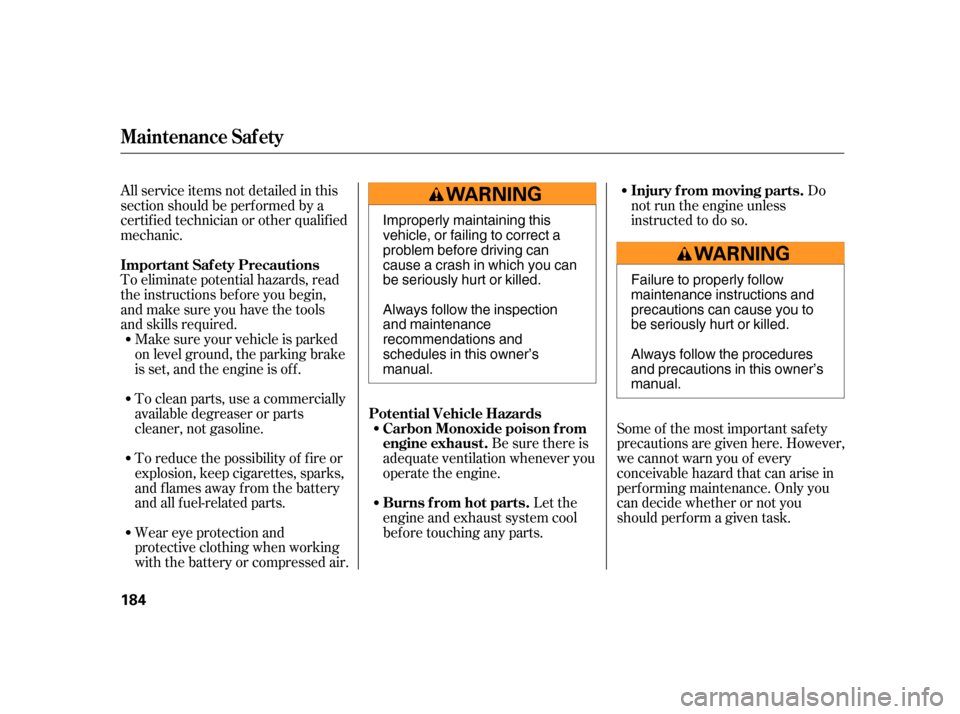
To eliminate potential hazards, read
the instructions bef ore you begin,
and make sure you have the tools
and skills required.
Make sure your vehicle is parked
on level ground, the parking brake
is set, and the engine is of f .
To clean parts, use a commercially
available degreaser or parts
cleaner, not gasoline.
To reduce the possibility of f ire or
explosion, keep cigarettes, sparks,
and f lames away f rom the battery
and all f uel-related parts.
Wear eye protection and
protective clothing when working
with the battery or compressed air.
Be sure there is
adequate ventilation whenever you
operate the engine.
Let the
engine and exhaust system cool
bef ore touching any parts.
Do
not run the engine unless
instructed to do so.
All service items not detailed in this
section should be perf ormed by a
certif ied technician or other qualif ied
mechanic.
Some of the most important saf ety
precautions are given here. However,
we cannot warn you of every
conceivable hazard that can arise in
perf orming maintenance. Only you
can decide whether or not you
should perf orm a given task.
Maintenance Saf ety
Important Saf ety Precautions
Potential Vehicle Hazards
Carbon Monoxide poison f rom
engine exhaust.
Burns f rom hot parts.
Injury f rom moving parts.
184
Improperly maintaining this
vehicle, or failing to correct a
problem before driving can
cause a crash in which you can
be seriously hurt or killed.
Always follow the inspection
and maintenance
recommendations and
schedules in this owner’s
manual.
Failure to properly follow
maintenance instructions and
precautions can cause you to
be seriously hurt or killed.
Always follow the procedures
and precautions in this owner’s
manual.